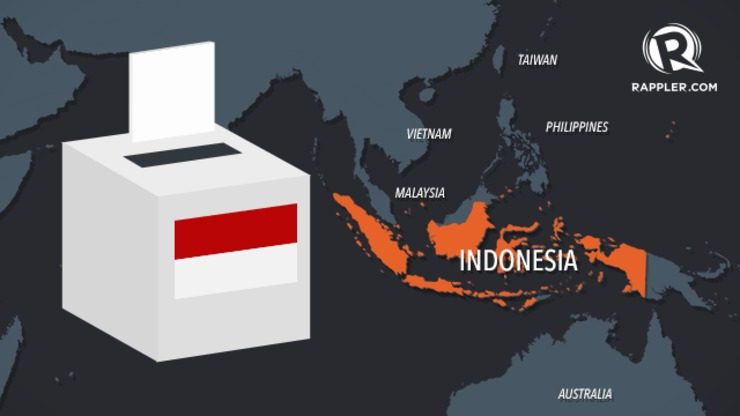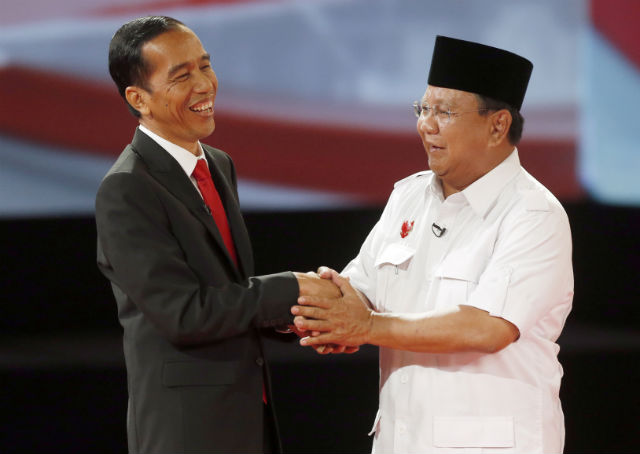SUMMARY
This is AI generated summarization, which may have errors. For context, always refer to the full article.

MANILA, Philippines – On Wednesday, July 9, almost 190 million registered voters are expected to participate in Indonesia’s third direct presidential elections.
Jakarta Governor Joko Widodo, commonly known as Jokowi, and former general Prabowo Subianto are vying for the presidency in the world’s biggest archipelago. (READ: Indonesian election too close to call)
LIVE BLOG: 2014 Indonesian Presidential Elections
But how different is the presidential polls in Indonesia compared to what we have in the Philippines? (READ: Between Jokowi and Prabowo: Why should the Philippines care?)
1. Presidential elections in Indonesia take place every 5 years.
The president of Indonesia can be reelected but only once. He or she is limited to two terms. Indonesia’s current president, Susilo Bambang Yudhoyono, was reelected in 2009 and would have been in power for 10 years by the time the new president is inaugurated in October 2014.
In the Philippines, the president is elected to just one 6-year term. The most recent presidential election happened on May 10, 2010. The next one will be on May 9, 2016.
2. The president and vice president of Indonesia are elected as a pair.
This means that the winning presidential candidate’s running-mate will be automatically elected as vice president.
On the contrary, Filipinos vote for their president and vice president separately. In 3 of the last 5 Philippine presidential elections (1992, 1998, and 2010), the winning vice president was not the president-elect’s running-mate.
3. A candidate must secure an absolute majority of the votes (at least 50%) nationwide to win. Otherwise, the top two candidates would face off in a run-off election.
In addition, the winner should also receive at least 20% of the vote in over half of Indonesia’s 34 provinces. (READ: What’s at stake in Indonesia’s elections?)
To date, a run-off election scenario has taken place only once in Indonesia’s history: in 2004, when 5 candidates ran for the presidency. No candidate reached the 50% treshhold, so the top 2 candidates – Susilo Bambang Yudhoyono and reelectionist Megawati Sukarnoputri – took part in the run-off polls.
Yudhoyono won, obtaining 61% of the votes. He was reelected with a majority victory in the first round in 2009. (READ: Jokowi, Prabowo reflect a decade of frustrations with SBY)
In the Philippines, however, first-past-the-post (plurarity) voting is followed. The candidate who gets the most number of votes wins, even if he or she does not obtain the majority of the votes.
All Philippine presidents since 1992 won with less than 50% of the votes.

4. Only parties/coalitions that win at least 25% of votes in the preceding legislative election or at least 20% of seats in the legislature can nominate a president-vice president ticket.
However, no political party passed either requirement after the 2014 legislative election in April. Thus, the parties formed coalitions.
The majority coalition in the legislature, called the People’s Representative Council (DPR), nominated Prabowo of the Great Indonesia Movement Party (Gerindra) party and his running-mate, former cabinet member Hatta Rajasa of the National Mandate Party (PAN). (READ: Why Prabowo is the president Indonesia needs today)
The ruling Democratic Party later backed Prabowo’s presidential bid.
Meanwhile, Jokowi of the Indonesian Democratic Party of Struggle (PDI-P) and his running-mate, former Vice President Jusuf Kalla, were nominated by the minority coalition. (READ: Indonesian voters place hopes in Jokowi’s past)
Kalla is from the Golkar party (he was chairman from 2004 to 2009), but Golkar chose to support Prabowo.
By contrast, in the Philippines, any political party can field a presidential or vice presidential candidate.
5. The voting age in Indonesia is 17 years old.
In addition, anyone who is married or has been divorced, regardless of age, can vote. They also have to have a Kartu Tanda Penduduk (KTP), or Resident Identity Card.
The voting age in the Philippines is one year older, or 18 years old. But there are youth council polls where only 15-to-17-year-old Filipinos can vote.
6. Indonesian voters punch holes on paper ballots with a large nail to vote for their preferred presidential candidate.
The votes are then counted and tabulated manually. But there have been moves to implement electronic voting (e-voting).
Meanwhile, the Philippines has an automated voting system via precinct count optical scan (PCOS) machines. Voters shade ovals beside the name of their chosen candidate on the ballot, which would then be fed to the PCOS machine. Votes are canvassed electronically. – Rappler.com
Add a comment
How does this make you feel?
There are no comments yet. Add your comment to start the conversation.